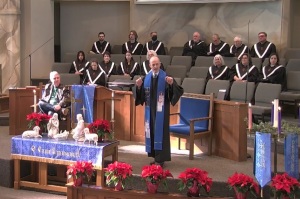Study: Religious Congregations Have Lowest Mortality Rate
Religious congregations in the United States have a "mortality rate" of 1 percent, which is the lowest among other organizations, according to a newly published study.
About 10 out of every 1,000 religious congregations disband each year, sociologists at the University of Arizona and Duke University found. The low rate of demise revealed that the religious organizations are some of the strongest in the nation, the report stated.
Among volunteer-based social service groups, peace movement organizations and other groups studied over the last two decades, at least 5 percent shut their doors each year. Only child care centers in Toronto came close to the low 1 percent mortality rate that religious congregations have, the study noted.
Despite the low rate of closures, Duke Univesity professor Mark Chaves cautioned that it could mean that "weak congregations limp along rather than die, whereas in other organizational populations weak units die rather than live on in a weakened state."
Chaves received grants in 2005 to begin the second wave of research into the 1998 National Congregations Study, which was the first in-depth study of religious organizations. He worked with UA graduate students to find how many congregations from the original survey were still active – holding regular services, maintaining bulletins and calendars, and holding passion plays and rallies, among other events – in 2005.
"Congregations are one of the most important types of voluntary organizations in our society and because we know so much about other kind of organizations we wanted to take a look at congregations," said Shawna L. Anderson, who managed the UA research team, according to a UANews release.
Knowing the mortality rate of religious congregations is critical to understanding their social influence and relevance, said Anderson, while noting that little information has been available about the life and death of religious organizations.
"Not only do people go to Sunday morning service, but they go to their congregations throughout the week and network though these organizations," she noted. "So, understanding the demography of the organizations is important to understanding other things related to congregations, such as how social networks are built and how they launch social movements."
The research team studied information from 1,230 churches, synagogues, and mosques of varying denominations, including Jehovah's Witness, Lutheran, Protestant, Episcopal, nondenominational Christian, Roman Catholic and others, with sizes that ranged from seven regularly participating members to 20,000.
They found that 27 congregations closed since the first wave of research; congregations that owned a building were more likely to remain open and active; about two-thirds of churchgoers attend congregations that have a Web site and 44 percent of congregations have sites; there was a 123 percent increase in the number of congregations with Web sites; and smaller congregations with a few dozen members were more likely to close than those with hundreds of members.
"The main difference between congregations doomed to disband and congregations destined for revival is a willingness to adapt, to alter their congregational identity in response to change in the communities in which they are located. And whether a congregation is willing to adapt depends largely on the outcome of conflict between advocates of the status quo and advocates of change," the researchers stated.
Researchers suggested that congregations are able to live because they are minimalists and require little funding to launch and survive. They are also flexible and adaptive and can easily reduce congregational activities and goals to a bare minimum, the team noted.
"Congregations can continue in this way for a long time, perhaps until a precipitating event like a major conflict pushes them over the edge."
Anderson believes a congregation's survival may be linked to the commitment of the members.
"If you've got a group of even only 10 people who are deeply committed to the organization whether it's because they've gone all their lives or got married there or had their kids baptized there, it's amazing what a congregation can pull from its membership," she said.
More research is required to determine exactly why congregations are able to "limp along and survive," as Anderson noted, while other organizations die.
The findings were published in the June issue of the Journal for the Scientific Study of Religion in an article titled "Dearly Departed: How Often Do Congregations Close?" Another comprehensive article is expected to be published in December.




























